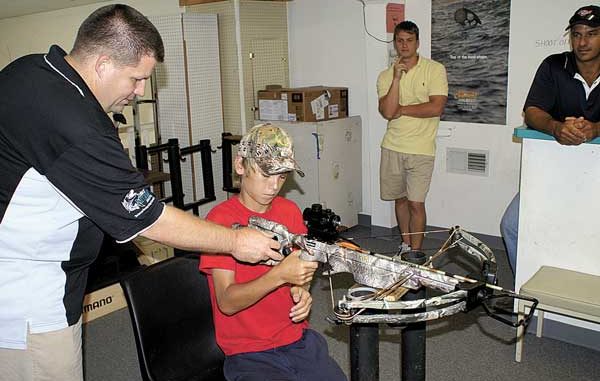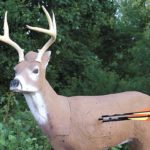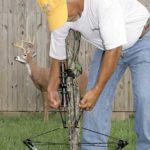
A new law makes crossbows fair game for deer, and hunters can’t wait to see them in action.
A deer walks into range. Quietly, the hunter takes aim through his scope. At just the right moment, the safety is clicked off and the hunter gently squeezes the trigger to send an arrow through the broadside buck. The deer runs only 50 yards before succumbing to the mortal wound.Arrow?
That scene will likely be played out for thousands of Louisiana archery hunters this year. Recently passed legislation now allows the use of crossbows during Louisiana’s archery-only deer season.
Prior to this year, the use of crossbows during archery season was limited to hunters over 60 years of age or those with a medically documented physical disability that prevented them from using more traditional, vertical archery equipment.
Modern crossbows, or X-bows as they are sometimes called, are gaining much favor as archery hunting weapons. In keeping with the growing national trend, the Louisiana Department of Wildlife and Fisheries sponsored the legislation to broaden the legal use of crossbows in the state.
“We support archery as a recreational form of hunting, and saw the expanding use of crossbows as a means to attract more hunters to the sport,” said Kenny Ribbeck, Wildlife Administrator for the LDWF. “There were no biological concerns with regards to overharvesting, and the department saw this as a way to allow increased hunting opportunities.
“Crossbows are easier to use than vertical archery equipment, and afford a great opportunity to increase the number of youth hunters.”
Crossbow proponents tout their user-friendly design as a good way to introduce new people to the sport of hunting. Crossbows allow new users to attain tight arrow groups more quickly than with traditional bows. This increases confidence and provides a unique opportunity to recruit and retain more youth and women hunters.
However, the legislation was not passed without some opposition. Organizations of traditional archery hunters generally oppose the use of crossbows during archery-only seasons. They believe that crossbows are more akin to firearms than they are bows, and should not be allowed during archery-only seasons.
While this debate may never be completely settled, the national trend is toward recognizing that crossbows are just another form of archery equipment.
“The department was utilizing significant manpower to review applications for disability-related crossbow permits,” Ribbeck said. “With no projected negative effects on the deer herd, the allowance of crossbows during the regular archer-only season will bring positive attention to archery hunting.”
Mike Houllis is well aware of the concerns regarding expanded use of crossbows. Houllis is an avid crossbow hunter and president of Barnett Outdoors. Barnett has been in the crossbow manufacturing business for decades.
“Make no mistake: Crossbows are archery equipment,” he said. “For a hunter to be successful with a crossbow, he still needs to become proficient with his weapon and employ hunting skills that will allow him to get within range of his quarry.”
Crossbows are truly a mix of technologies and features found on the finest vertical archery equipment and rifles. However, like all modern weapons, they have their limitations and are best suited for their specific intention.
“One of the biggest myths regarding crossbows is that they offer a much longer effective range than traditional compound or recurve bows,” said Houllis. “That is simply not the case.”
Almost all crossbow manufacturers list their maximum effective range as 40 yards. As in most archery-hunting situations, the average shot at a deer is 20 yards or less.
“To be successful, crossbow hunters must hone their skills like any good archer,” Houllis said. “To get an opportunity for a shot, you have to learn proper stand placement, scent management, distance judging, movement control and all the little nuances that make for successful archery hunters.”
Like traditional vertical bows, crossbows come in both compound and recurve models. However, due to their short “power stroke,” crossbows must have about twice the draw weight as traditional bows to achieve the same arrow speed. Relatively noisy when shot and a bit cumbersome to cock, crossbows are considered “one-shot” weapons.
Houllis concedes it is generally easier to become more proficient with a crossbow than it is using more traditional archery equipment.
“With a scope, trigger and safety, a crossbow is more familiar to gun hunters than archery hunters. Gun hunters are the new crossbow hunters,” he said.
Gun hunters who try crossbow hunting will quickly experience what is inarguably the major attraction to archery hunting — getting up close and personal with wild game. While shooting a deer with a rifle at 150 yards has its own appeal, being close enough to a deer to hear it breathe adds a whole new dimension.
With the growing popularity of crossbows, hunters have sought out each other to learn more about the sport, exchange ideas and, of course, brag about their kills. Additionally, with the proverbial “strength in numbers,” their combined efforts have helped to further expand the hunting opportunities available for crossbow hunting.
The formation of groups such as the American Crossbow Federation (ACF) has greatly aided in the advancement of crossbow hunting.
“We consider ourselves the NRA of crossbow hunting,” said Daniel James Hendricks, CEO of the ACF. “We are dedicated to the preservation of all forms of hunting.”
The ACF has individual members from every state, and is continually adding new state-affiliate chapters.
“We would welcome a Louisiana chapter, and certainly believe the opening of the full archery season to crossbow use will spur a lot of interest,” he said.
Members receive a subscription to the group’s Horizontal Bowhunter magazine.
Hendricks advises first time crossbow purchasers to handle and shoot as many different brands and models as possible.
“What do you want? What do you like?” he said. “Even the most experienced hunters have likely never handled a crossbow. By shooting many different ones, you will be able to tell which one is right for you.”
Though crossbows have some combined features found on guns and vertical bows, they have some unique characteristics only found on a crossbow.
Crossbow features that most gun and archery hunters may be familiar with are the trigger, safety, scope, limbs, stock, arrow, etc. However, others such as the flight groove, arrow retention spring and cocking stirrup may seem like a foreign language. The owner’s manual will identify and explain each of these features.
So you want to be a crossbow hunter? So do I.
I have been a gun hunter for more than 30 years and a bow hunter for more than 25. I have taken numerous trophies all across the country with various models of vertical compound bows. Archery hunting is my favorite method, and I must say that the opening of the Louisiana season to crossbows has strongly piqued my interest.
Having never so much as held a crossbow, I too would be starting from scratch. Armed with the advice above, I visited with Sammy Romano, manager of Chag’s Sporting Goods in Metairie. Romano is a highly experienced archer, and has sold and serviced thousands of vertical bows and many crossbows.
The first day I visited with Romano, the sparked interest in Louisiana crossbow hunting was obvious. The store was well stocked with a dozen or so crossbows hanging from the ceiling. Nearby boxes held many more.
“The bill was just signed by the governor, and the word is beginning to spread,” he said. “We’re seeing more interest in crossbows as each day goes by.”
While I was trying to pick Romano’s brain and not interfere with his customers’ service, Gary Cooper of Covington showed up and was interested in purchasing a crossbow. Talk about great timing. I got to see first-hand all the steps Romano goes through to help someone select the crossbow that’s right for him.
Cooper explained that due to a disability with his arm, he actually went through the crossbow permit process last year, but got the permit too late in the season to begin hunting. After thoroughly checking out several models and brands, Cooper selected a TenPoint brand crossbow with a red-dot scope and a cocking device built into the stock.
With Cooper and me looking on, Romano proceeded to assemble the crossbow in only a few minutes’ time. Then it was upstairs to Chag’s indoor archery range for further instructions and sighting in.
After going over the main features of the crossbow and stressing the importance of reading the owner’s manual, Romano showed Cooper how easy it is to cock the crossbow with the use of the cocking device. Two small clips hook on the bow string on each side of the rail. With a foot placed in the stirrup, it’s simply a matter of pulling up on the cocking rope handles until the string locks in place.
Cooper’s bow, as is the case with most, automatically goes on safety when the bow is cocked. The built-in cocking rope is retracted back into the stock and the bow is ready to be loaded with an arrow.
Cooper was now set for his initial shot at 10 yards. With a field-tipped arrow placed in the flight groove, the crossbow was ready to aim and fire. Cooper placed his top dot on the target, and clicked the safety to fire.
With a light squeeze of the trigger, the short arrow was propelled to the target at a blazing speed. At only 10 yards, the sound of the bow going off and the whack of the arrow hitting the target were simultaneous.
The arrow hit the target within one inch of the half dollar-sized bull’s-eye — just a little high and to the right.
“That’s pretty close,” Romano said. “We can move back to 20 and get it on the money.”
With a few clicks on the red dot scope and a few more shots at 20 yards, Cooper was grouping arrows at 1 inch with only seven shots fired. He even placed one in the exact hole as a previous shot. Luckily, the prior arrow had been removed, or he would have ruined a brand-new arrow.
All that’s left now is for Cooper to practice with his new crossbow and to fine-tune his sight with his selection of broadheads. As with traditional archery equipment, broadhead-tipped arrows will fly a little differently than field points. The use of mechanical broadheads will usually lessen the difference in arrow flight.
Romano believes the expanded use of crossbows will be a good addition to archery hunting. Unlike traditional vertical bows, which take more time to master and must be fitted to the individual user, a sighted-in crossbow can generally be used by any individual with accurate results.
“Crossbows allow you to introduce someone to archery hunting with much less practice and preparation,” Romano said.
A week later, it was my turn. Using the same selection procedures, my choice was a Horton Legend with a 175-pound draw weight and Horton’s “Mult-A-Range” four-power crossbow scope.
The addition of the rope-cocking device made the bow very easy to cock. To gain first-hand knowledge (and to stay out of Romano’s hair), I wanted to shoot and sight in the crossbow on my own.
Using the same sighting procedures that Romano had previously instructed, sighting in my crossbow was easier to do than with any gun or bow I have ever had. I was driving 20-yard tacks after less than a dozen shots. Consistent one-inch groups were easily repeated with some arrows touching each other. The Horton Mult-A-Range scope has five crosshairs to compensate for arrow drop at different distances.
I can’t wait to put it to use when a deer is so close I can hear it breathe.







